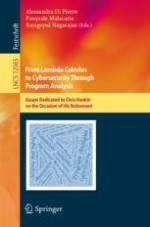2020 | OriginalPaper | Buchkapitel
Cathoristic Logic
A Logic for Capturing Inferences Between Atomic Sentences
verfasst von : Richard Evans, Martin Berger
Erschienen in: From Lambda Calculus to Cybersecurity Through Program Analysis
Aktivieren Sie unsere intelligente Suche, um passende Fachinhalte oder Patente zu finden.
Wählen Sie Textabschnitte aus um mit Künstlicher Intelligenz passenden Patente zu finden. powered by
Markieren Sie Textabschnitte, um KI-gestützt weitere passende Inhalte zu finden. powered by
